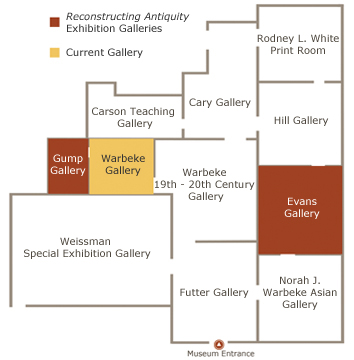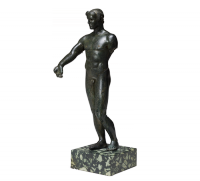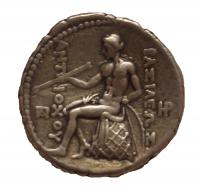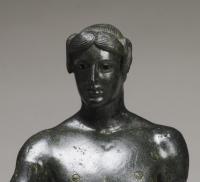Standing figure of a youth, probably Apollo
Learn more about the object below
Apollo was god of light, music, healing, and prophecy, and his many epithets refer to his varied areas of influence. He was called the “Far-Shooter” because Apollo, like his twin sister Artemis, was associated with archery. The name “Phoebus,” meaning “bright one,” came from his association with the sun and light. Lastly, the appellation “Pythian Apollo” is associated with his role in prophecy. Apollo killed the monster Python at Delphi and established a woman, Pythia, as prophetess there. Under the protection of Apollo, the female oracle at Delphi became the most famous in the Greek world.
Before the Classical period (480-323 BCE), statues depicting kouroi (young men) stood stiffly upright, staring straight ahead and not moving. Musculature, facial expressions, and movement became more natural by the beginning of the 5th century BCE, as is evident in this bronze sculpture from ca. 470 BCE. The new artistic style depicted ideal men: strong, athletic, youthful (beardless) and beautiful. It was the embodiment of the expression kalos kai agathos (the beautiful and the good), which men strove to achieve in their appearance, intellect, and actions. As the skill of the sculptors rose, the range of motion increased until, by the Hellenistic period (330-31 BCE), figures could be shown in elaborate, rhythmic motion.
Bronze, an alloy of copper and tin, was a common material for ancient statuettes due to its low melting point and malleability. The artist would create a wax figurine and then build a ceramic mold around it. Next, molten bronze was poured into the mold, melting out the wax and filling the cavity. Some details of the sculpture were modeled in the original wax figurine, while other elements were cold worked onto the finished bronze product. When first made, an ancient bronze would have been a shiny, metallic brown. This statuette has developed a coating called a patina over time, causing it to appear green and black.
Label text by Lisa Anderson, Frederick Randolph Grace Assistant Curator of Ancient Art, Harvard Art Museums.
Suggested readings:
M. P. O. Morford and R. J. Lenardon, Classical Mythology, 7th edition, Oxford University Press, 2003.
J. J. Pollitt, Art and Experience in Classical Greece, Cambridge University Press, 1972.
C. C. Mattusch, Classical Bronzes: The Art and Craft of Greek and Roman Statuary, Cornell University Press, 1996.





